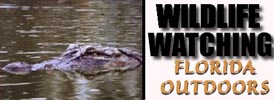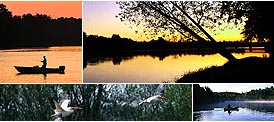


Alligators
Black Bear
Whooping Crane
Bald Eagle
Manatee
Florida Panther
Brown Pelican
The American alligator is a member of the crocodile family, whose members are living fossils from the Age of Reptiles, having survived on earth for 200 million years. However, the alligator can be distinguished from the crocodile by its head shape and color. The crocodile has a narrower snout, and unlike the alligator, has teeth in the lower jaw which are visible even when its mouth is shut. In addition, adult alligators are black, while crocodiles are brownish in color.
Today, alligators are found throughout the Southeast, from the Carolinas to Texas and north to Arkansas. As during the Reptile Age, today alligators live in wetlands, and it is this vital habitat that holds the key to their continued long-term survival. Alligators depend on the wetlands -- and in some ways the wetlands depend on them. As predators at the top of the food chain, they help control numbers of rodents and other animals that might overtax the marshland vegetation. The alligator has a large, slightly rounded body, with thick limbs, a broad head, and a very powerful tail which it uses to propel itself through water. The tail accounts for half the alligator's length. While alligators move very quickly in water, they are generally slow-moving on land, although they can be quick for short distances. Alligators will eat just about anything, but primarily consume fish, turtles, and snails. Small animals that come to the water's edge to drink make easy prey for the voracious alligator. Young alligators mostly feed on insects, crustaceans, snails, and fish. The alligator's greatest value to the marsh and the other animals within it are the "gator holes" that many adults create and expand on over a period of years. An alligator uses its mouth and claws to uproot vegetation to clear out a space; then, shoving with its body and slashing with its powerful tail, it wallows out a depression that stays full of water in the wet season and holds water after the rains stop. During the dry season, and particularly during extended droughts, gator holes provide vital water for fish, insects, crustaceans, snakes, turtles, birds, and other animals in addition to the alligator itself. Sometimes, the alligator may expand its gator hole by digging beneath an overhanging bank to create a hidden den. After tunneling as far as 20 feet, it enlarges the end, making a chamber with a ceiling high enough above water level to permit breathing. This is not the alligator's nest but merely a way for the reptile to survive the dry season and winters. The breeding season begins in the spring. Although alligators have no vocal cords, males bellow loudly to attract mates and warn off other males during this time by sucking air into their lungs and blowing it out in intermittent, deep-toned roars. The female builds a nest of vegetation, sticks, leaves, and mud in a sheltered spot in or near the water. After she lays her 20 to 50 white, goose-egg-sized eggs, she covers them under more vegetation, which, like mulch, heats as it decays, helping to keep the eggs warm. She remains near the nest throughout the 65- day incubation period, protecting the nest from intruders. When the young begin to hatch they emit a high-pitched croaking noise, and the female quickly digs them out. The young, which are tiny replicas of adult alligators with a series of yellow bands around their bodies, then find their way to water. For several days they continue to live on yolk masses within their bellies. Alligators reach breeding maturity at about 8 to 13 years of age, at which time they are about 6 to 7 feet long. From then on, growth continues at a slower rate. Old males may grow to be 14 feet long and weigh up to 1,000 pounds during a lifespan of 30 or more years. Historically, alligators were depleted from many parts of their range as a result of market hunting and loss of habitat, and 30 years ago many people believed this unique reptile would never recover. In 1967, the alligator was listed as an endangered species (under a law that preceded the Endangered Species Act of 1973), meaning it was considered in danger of extinction throughout all or a significant portion of its range. But a combined effort by the U.S. Fish and Wildlife Service and state wildlife agencies in the South saved these unique animals. The Endangered Species Act prohibited alligator hunting, allowing the species to rebound in numbers in many areas where it had been depleted. As the alligator began to make a comeback, states established alligator population monitoring programs and used this information to ensure alligator numbers continued to increase. In 1987, the Fish and Wildlife Service pronounced the American alligator fully recovered and consequently removed the animal from the list of endangered species. Although the American alligator is secure, some related animals -- such as several species of crocodiles and caimans -- are still in trouble. For this reason, the Fish and Wildlife Service still regulates the legal trade in alligator skins, or products made from them, in order to protect these endangered animals with skin that is similar in appearance, but illegal in the commercial market. The story of the American alligator is one of both drastic decline and complete recovery, it is a story of state and federal cooperation, and it is truly one of the prominent success stories of the nation's endangered species program.
Information provided by:
Fish and Wildlife Service
















